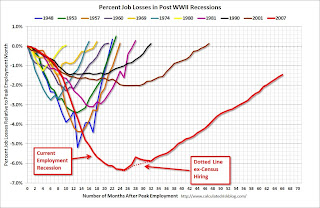by Calculated Risk on 8/02/2013 08:30:00 AM
Friday, August 02, 2013
July Employment Report: 162,000 Jobs, 7.4% Unemployment Rate
From the BLS:
Total nonfarm payroll employment increased by 162,000 in July, and the unemployment rate edged down to 7.4 percent, the U.S. Bureau of Labor Statistics reported today. ...The headline number was below expectations of 175,000 payroll jobs added. Employment for May and June were also revised lower.
...
The change in total nonfarm payroll employment for May was revised from +195,000 to +176,000, and the change for June was revised from +195,000 to +188,000. With these revisions, employment gains in May and June combined were 26,000 less than previously reported.
 Click on graph for larger image.
Click on graph for larger image.NOTE: This graph is ex-Census meaning the impact of the decennial Census temporary hires and layoffs is removed to show the underlying payroll changes.
The second graph shows the unemployment rate.
The unemployment rate declined in July to 7.4% from 7.6% in June.
 This is the lowest level for the unemployment rate since November 2008.
This is the lowest level for the unemployment rate since November 2008.The unemployment rate is from the household report and the household report showed a larger increase in employment than the establishment report, and that combined with a decline in the participation rate meant a lower unemployment rate.
The third graph shows the employment population ratio and the participation rate.
The Labor Force Participation Rate decreased to 63.4% in July (blue line) from 63.5% in June. This is the percentage of the working age population in the labor force.
 The participation rate is well below the 66% to 67% rate that was normal over the last 20 years, although a significant portion of the recent decline is due to demographics.
The participation rate is well below the 66% to 67% rate that was normal over the last 20 years, although a significant portion of the recent decline is due to demographics.The Employment-Population ratio was unchanged in July at 58.7% (black line). I'll post the 25 to 54 age group employment-population ratio graph later.
 The fourth graph shows the job losses from the start of the employment recession, in percentage terms, compared to previous post WWII recessions. The dotted line is ex-Census hiring.
The fourth graph shows the job losses from the start of the employment recession, in percentage terms, compared to previous post WWII recessions. The dotted line is ex-Census hiring.This shows the depth of the recent employment recession - worse than any other post-war recession - and the relatively slow recovery due to the lingering effects of the housing bust and financial crisis.
This was below expectations. I'll have much more later ...


